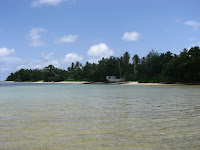For a moment let’s put the cart before the ox. Let’s imagine the world before man. The oceans waters are sparkling gemstones – turquoise, aquamarine, lapis and sapphire, while the vegetation radiates emerald, jade, rubies and corals. Giant tortoises lumber on the land marking their territory; crocodiles and turtles rule the submarine landscape; and fairy terns or tropic birds ride the air like free spirits. Everywhere, the pristine, primeval glory of the Earth lies untouched, unspoilt. This idyll still persists on many remote islands of the Seychelles Paradise on earth” and “Another world”. After exploring Mahe, the principal island of Seychelles
The first hop is the charming island of La Digue India
Though they seem to dominate the skyline, the coconut palms are not native to Seychelles Seychelles India
 As we headed to the beach away from the artificiality of the jetty, we hit upon deserted roads, the La Digue I was eager to see. I was intrigued by the sight of a bikini-clad young mother on a rickety scooter zipping by with her daughter as a pillion. Their appearance defied racial profiling - not African, nor Asian, nor European, perhaps an amalgamation of the three! I, subsequently, learnt that the early settlers on this virgin island were French - political rebels from Réunion - and today’s population is their direct descendants. Just as I could not put my finger on their ethnicity, I was also unable to slot them in any socio-economic class, an exercise we so idly indulge in everywhere but which seemed so futile here. Are they “rich” or do they belong to the “middle-class”? Do they live in a big mansion with a swimming pool like the filthy rich Europeans settled in
As we headed to the beach away from the artificiality of the jetty, we hit upon deserted roads, the La Digue I was eager to see. I was intrigued by the sight of a bikini-clad young mother on a rickety scooter zipping by with her daughter as a pillion. Their appearance defied racial profiling - not African, nor Asian, nor European, perhaps an amalgamation of the three! I, subsequently, learnt that the early settlers on this virgin island were French - political rebels from Réunion - and today’s population is their direct descendants. Just as I could not put my finger on their ethnicity, I was also unable to slot them in any socio-economic class, an exercise we so idly indulge in everywhere but which seemed so futile here. Are they “rich” or do they belong to the “middle-class”? Do they live in a big mansion with a swimming pool like the filthy rich Europeans settled in
We leave the “timelessness” behind to enter a “before time” zone, if you know what I mean. In the heart of Praslin Island Seychelles Seychelles
Next hop, Aldabra Island, hopefully, in this lifetime!
Also read Seychelles - Part I: http://padmaja-earthletters.blogspot.com/2011/02/island-unto-itself.html
NOTE: All Photographs in this blog and website are the author's original work.








Superb pictures and lovely write-up! I remembered a video that is linked to what you have mentioned about coco de mer. It is a TED talk by Jonathan Drori.
ReplyDeleteCheck out- http://www.youtube.com/watch?v=YmVZ8zXJO48